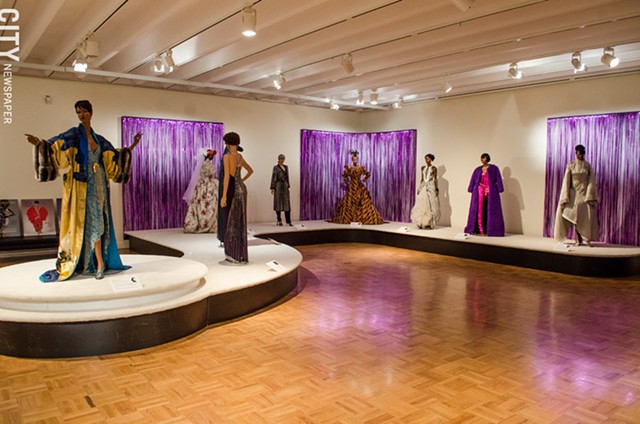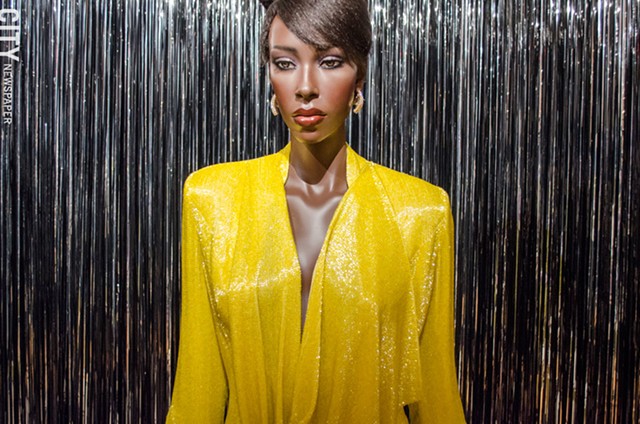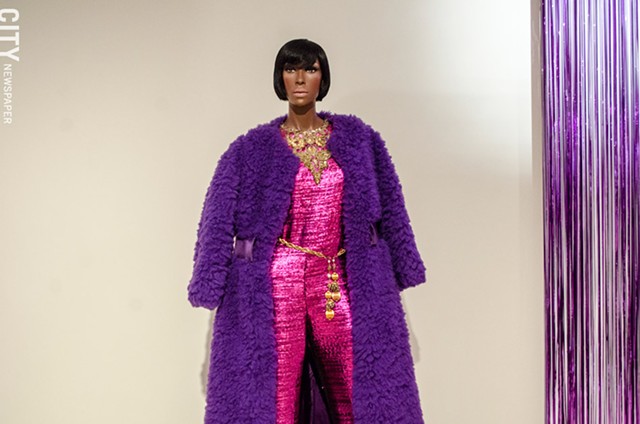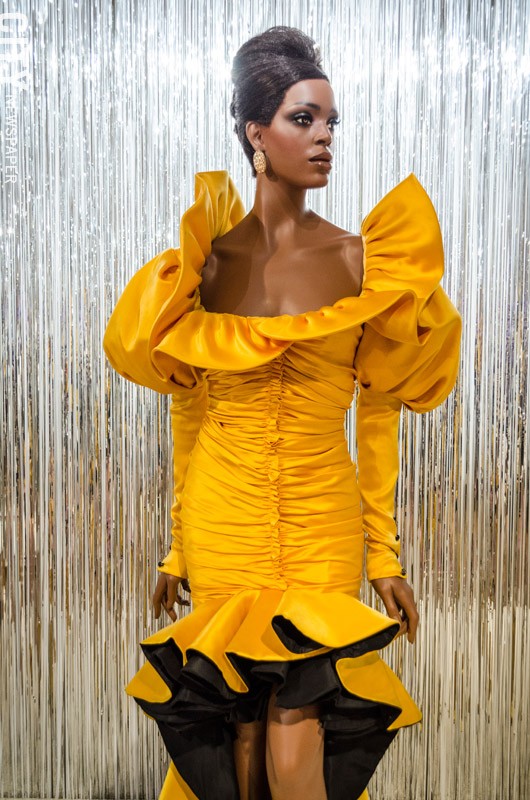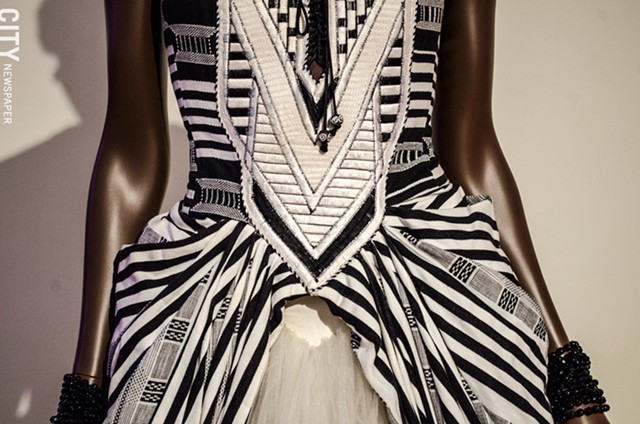
[
{
"name": "500x250 Ad",
"insertPoint": "5",
"component": "15667920",
"parentWrapperClass": "",
"requiredCountToDisplay": "1"
}
]
There are many ways to consider the display of dazzling, haute couture ensembles in "Inspiring Beauty," the current exhibit hosted at Memorial Art Gallery. The outfits are sculptural wonders. They are a fascinating, diverse, curated slice of high design history. They are also historically important as part of a collection that toured American cities during five decades of the annual Ebony Fashion Fair, which sought to give black communities more access to and participation in the international world of fashion.
More than an exhibit of glamorous garments, "Inspiring Beauty: 50 Years of Ebony Fashion Fair" offers an excellent opportunity for discussion about the inclusion of people of color in areas of culture that define our collective identity, and what work still remains unfinished on this front.
John H. Johnson launched Ebony, the first of many black lifestyle magazines he would publish, in Chicago. It was 1945, and the Second Great Migration had just started, during which Chicago's African-American population saw a massive boom. In addition to printing articles about social movements and black icons, Ebony promoted the pursuit of a higher level of lifestyle to a large population of people who had been closed out of participating in, or being represented by, mainstream American culture.
Eunice Johnson, John's wife and partner, was a crucial part of the operation. One of her roles was attending couture shows and buying clothing for models to wear in the magazines. But she was denied entrance to some of these shows in the beginning, says Marie Via, MAG director of exhibitions.
"She had to work very hard to prove that yes, she was going to be purchasing some of these things. And yes, there was a massive audience for this out there," Via says.
Given this struggle to prove herself, and gain access to buying high couture items, we can credit Eunice's success to her skills in deftly navigating standing racism and forcing white enterprises to see they were missing out on a large and viable market.
The entry ticket for Eunice was the fact that she was a serious purchaser, says Joy L. Bivins, curator at the Chicago History Museum, where the "Inspiring Beauty" exhibit originated in 2013. The Johnsons' publications were met with an enthusiastic response from their audience. "So by the time the Ebony Fashion Fair gets moving, there were very few designers who refused to work with her," Bivins says.
Bivins provides a wealth of history about the Ebony Fashion Fair in the show catalog that accompanies the exhibit. "In 1956, Jesse Dent, wife of Dillard University's president, approached John H. Johnson about supplying models for a fashion show fundraiser for Flint-Goodridge Hospital" Bivins writes. Though he was reluctant to share the models, Johnson offered to supply clothing, with the caveat that each ticket to the show would include a subscription to either Ebony or Jet, one of Johnson's other publications.
The charity show was successful, and in 1958, Johnson Publishing Company launched its own traveling show, the Ebony Fashion Fair. The tour took place annually until 2009.
"One of the things I like to remind people about the Ebony Fashion Fair, and couture in general, is a lot of us just don't have exposure to that, we're just not visiting couture shops," Bivins says. "We're not having things made for us that cost tens of thousands of dollars. The Ebony Fashion Fair brought all of that to people where they were. So for the designers, yes, it was a wonderful platform, but in terms of educating the public about fashion, and giving people the opportunity to see those things up close and personal, was the real strength of the show."
"Inspiring Beauty" showcases the legacy of "the determination on Mrs. Johnson's part to recognize that black women are beautiful, that they also want to express themselves through what they wear, and they should have access to couture as well as interesting ready-to-wear items, same as anybody," Via says.
This exhibit is the culmination of a long-time dream to have a couture show hosted at the MAG, Via says. "I was very inspired by a show I saw at the Costume Institute a long time ago, that kind of opened my eyes to the fact that fashion was sculpture in many ways. These are designers, artists, who are bending materials to their will, or inventing new materials, or inventing new techniques to make them do what they want to do."
When "Inspiring Beauty" was originally presented at the Chicago History Museum, the focus was more on historical elements of the Ebony Fashion Fair, "but for us it made more sense to treat it like a sculpture show," Via says.
Here, the ensembles are showcased front and center, though MAG does include information on the crucial elements of the Johnsons' publishing company and the origin and impact of the fashion fair. Besides the garments, the show presents invitations to couture shows, shots of models on the runway, and in the Lockhart Gallery down the hall, three short videos — about the fashion fair, the Johnson publishing empire, and other historical footage — are running on a loop. Also displayed in the Lockhart are replicas of Ebony covers from throughout the decades.
The Grand Gallery is loosely divided into three sections. Each showcases one of the guiding principles that were Eunice Johnson's credo, and which together spell V.I.P.: Vision, Innovation, Power. Not wanting to outshine the garments, MAG exhibitions designer John King created a simple staging of elevated, carpeted runways and a background of rain curtains — long strips of metallic Mylar in different colors. These backdrops add to the glamor of the scene, and movements from viewers create a gentle stirring and twinkling effect.
The 40 ensembles in "Inspiring Beauty" are presented on custom-made mannequins with a range of skin tones, hair textures, and facial features representative of the variety in what it means to be a black woman.
"Each mannequin was custom-designed for the piece that it displays," Bivins says. "The boldest and most vibrant colors were often displayed on the darkest-skin model that was traveling with the Ebony Fashion Fair at a particular time. So we wanted to highlight that idea and also wanted our visitors to be able to see themselves in the way that the garments were displayed."
A major concept of the fashion fair is that while the garment and designer are important, the display of the garment on black bodies is really critical as well, she says. "That's something we wanted to reflect in the exhibition."
One notable element missing from this representation is a variety in body types. All but one of the mannequins have the statuesque, willowy frame that still dominates the fashion industry. On the sole "plus-sized' mannequin is a Todd Oldham evening dress from the late 1990's — an earth-toned, full skirted satin affair with bursts of floral accents in sequins and glass beads. The gown is pinned in the back, because though the dress was made for a genuinely full-figured woman, the mannequin can't actually be more than a size 12 or 14.
So Eunice did show designs that were made for curvier women, even if the exhibit isn't representative of that fact.
For five decades, the annual Ebony Fashion Fair show travelled to 187 large cities all over the country, including Rochester. The team of models and show support as well as the clothing traveled via Greyhound bus. The group would set up wherever they could get a spot, which might be a high-end theater, but especially earlier on, could be a church, an auditorium or gymnasium in a school, or a party room in a hotel.
During the course of planning to host "Inspiring Beauty," "we spoke with people here in Rochester who had attended the Ebony Fashion Fair. It was apparently the social highlight of the year for many people," Via says.
The crowds would come to the event dressed nearly as elegantly as the models themselves, Bivins says. At each venue, the show lasted from an hour and a half to two hours, showcasing 100 to 200 different ensembles that represented everything from daywear to swimwear, evening wear, resort wear, and wedding gowns.
Guys also participated in the Fashion Fair as escorts for the models. Three men's outfits are showcased in this exhibit — including a striking Guy Laroche 1970's silk and taffeta, plaid evening suit covered in transparent, pearlescent sequins. A designated emcee would introduce each of the outfits on the runway, "and often the shows also included some performance aspect of dancing, singing, or the acting out of skits in the garments to bring them life," Bivins says.
True to its origins every year it was held, the Ebony Fashion Fair was an important fundraising event, supporting whatever organization brought the show to a particular town. Groups included the United Negro College Fund, a variety of black sororities and fraternities, and other black civic service organizations that would use the fair as their primary fundraising event for the year.
Each year, the show had a theme. In 1986, it was "I Love Fashion Scandal." For this show, French designer Patrick Kelly was commissioned to create a dress, and his creation — a black, knit, body-hugging number — features giant decorative eyes and lips on the front and the theme's title spelled out on the back in buttons, his signature motif.
It's easy to pinpoint some of the decades the outfits hail from without looking at the provided info. Some of the dramatic, opulent gowns look like they walked off the set of "Dynasty," while some have a distinctive Mod flair; other outfits feature the dressed-up, hip version of grunge elements so iconic in the 90's.
Despite the majority of the designers being European and American, a variety of world influences are showcased in the garments. Japanese designer Hanae Mori's early-aughts evening ensemble incorporates traditional hand-painted silk kimono elements and imagery with opulent chinchilla-lined cuffs on the sleeves.
African-style elements make a dramatic appearance, too. African-American designer Henry Jackson's 2005 ball gown is staggeringly gorgeous. The sleeveless bodice and full-length skirt are constructed of black and white West African woven cotton, its geometry and structure giving way to a diaphanous cloud of white tulle floating out from the gown's opening in the front.
It's incredibly disappointing that a designer of such marvels doesn't have as wide an audience today as he should. Part of Eunice's aim was to provide a platform for black designers to be on the same stage as Oscar de la Renta and Yves Saint Laurent and Givenchy.
"She believed these younger designers, who were coming up and didn't have a real audience before, deserved a place alongside the established designers," Bivins says. "In the beginning, from what I understand, they would go to different towns and ask who was the 'Negro designer' working in the town, and they would feature those designs in the show." In addition, the support staff members were all black: the costumers, the seamstresses, the makeup artists, the hairdressers, and the emcee. "Where does that happen now? I'm not sure."
"Inspiring Beauty" is indeed a celebration of the achievements of the Johnsons and their efforts to inspire communities of color toward a higher standard of living, their fight to gain access to couture for communities of color, their creation of opportunities for inclusion of black artistic expression in the global fashion industry, and access to black representation in the wider American identity.
But within the current context, we can see there is still much more work to do. We see criticisms about the whitewashed Oscars, about the ways unequal treatment of models of color manifest, and about subliminal messages regarding white supremacy in beauty in fashion magazines.
Author and former runway model Deborah Gregory says she experienced discrimination in the 1980's that drove her out of the country, and she doesn't think things have vastly improved.
When she approached Ford Modeling Company for work in the 80's, they told her their quotas for black models had been filled and she should go overseas. "They would send all the black girls to Europe," she says. "So, when you got there, there were a lot of black girls working. You'd go to the open calls, and they would say right to your face, 'No more black girls today.' Just like that. That's the way business was."
The industry's ideas of diversity were more along the lines of gathering white girls from all over Europe, than of including more women of color. "When you worked in Europe, especially in Italy, models came from Sweden, Yugoslavia, Germany, Paris, you name it," she says. "The white girls were more desirable."
Ebony Fashion Fair had its influence only within a finite sphere, Gregory says. "In Europe, it had even less influence. But there was less work for black models in America, and I don't think it's ever changed." She says she has the sense that there are fewer black models now than there were in the past, and even fewer black designers working now than there were then.
"Back then it was the end of the Civil Rights era," Gregory says. "So I think it was the trickle over — people were excited from that movement, but then things changed. And it's business as usual, and look, white business as usual. When you think of all the amazing talents that are out there, these people are not reflected."
Gregory says that while there are women of color working as models, they don't have much visibility or power within the field. "We don't even have a black supermodel at the moment," she says. "We have Naomi, Tyra, the old ring, but who's really hot now, young? You've got a few working — Liya Kebede, Chanel Iman — but they're not making the kind of noise that a supermodel makes."
And while some black designers work for major fashion houses, their names typically aren't on the labels. "There isn't anybody with a name anymore except for Tracy Reese," she says. "Lafayette 148, for example, is not a black company, but they have a black designer working for them, Edward Wilkerson. But his face is not out there. There is no one. Stephen Burrows, he had his own little boutique, for example. You would see Scott Barrie have a little trunk show. Willi Smith was huge, even when I was in Europe. You don't have that today anymore. What black designer is so visible? None."
The black designers who were consistently featured in the Ebony Fashion Fair wouldn't have been necessarily well known to the rest of the fashion industry, or even well known to fashion insiders, Bivins says. "I think the access issue for black designers was probably very pronounced when the show started in the late 1950's. But it's still an issue today, and most often, black designers — unless it's Tracy Reese, that's a name we've all come to know — they're missing. They're not part of the machine of the fashion industry. You don't necessarily see them at Fashion Week."
One exception is American designer B Michael, who was a fashion fair participant and is a fixture at New York Fashion Week. "But he's one of — you see me struggling to come up with names, right?" Bivins says. "There are black designers who work for fashion houses, and may be the head designer, but the amount of capital that is required to actually have your own line and maintain that is an issue for African-American designers."
Gregory says that a change will come with investors, with fellowship programs, and with mentoring. "There needs to be some sort of venture capital, more backing of young black designers," she says. "There needs to be an effort."
In her own life, Gregory has identified gaps in representation and filled them. She's the author of a successful young adult book series, "The Cheetah Girls" — about a group of five girls who form a singing group — which became a billion dollar, globally-distributed "Cheetahrama" franchise with concerts, dolls, fashion accessories, and three movies.
"There was such a lack of diversity in children's books," she says. "It was so severe, 15 years ago. There was nothing. It was ridiculous." She planned a multicultural story with characters from many different ethnic backgrounds — something that could conceivably appeal to all young girls, because they could all see themselves reflected in it.
Ultimately, the aim was to provide young people of color with more places to see themselves reflected in culture. "It is so crucial to their development," she says. "To this day, these children are growing up with very poor images of themselves, because of this lack of diversity."
Both Joy L. Bivins and Deborah Gregory will visit Rochester as part of a series of talks and events held in conjunction with the "Inspiring Beauty" exhibit. Visit mag.rochester.edu for more information.
Speaking of...
-
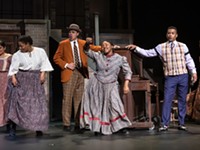
“Ragtime” evokes history through rhythm and rhyme
May 8, 2023 -

Film review: 'Ralph Breaks the Internet'
Nov 27, 2018 -

Seasonal exhibitionism
Sep 16, 2015 - More »
Latest in Art
More by Rebecca Rafferty
-

Beyond folklore
Apr 4, 2024 -

Partnership perks: Public Provisions @ Flour City Bread
Feb 24, 2024 -

Raison d’Art
Feb 19, 2024 - More »
